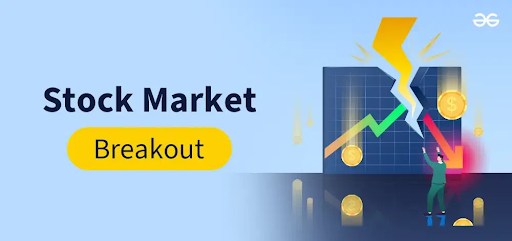‘Breakout trading’ is one of the most fundamental and popular concepts in the technical analysis of the stock market. Therefore, if you have just opened a demat trading account, you might have heard or read about breakout trading. But, what is a breakout in trading?
When a stock’s price breaches a considerable level of resistance or support and this price movement is accompanied by a high trading volume, it is called a breakout. Traders can access several intraday trading indicators like moving averages, stochastic oscillators, volume indicators, etc. to identify breakouts.
How does breakout trading work?
Let us take an example to understand what is breakout in trading. Suppose that a trader has been carefully tracking the price of a banking stock for a while now.
He has noticed that the price of this stock oscillates between Rs. 100 and Rs. 120. If for a long period, the price of a stock remains in a particular range, it shows that there is a balance between its demand and supply.
The trader understands that this stock has a resistance at the level of Rs. 120. In other words, if it breaks the barrier of Rs. 120 with increased volume, it will remain above Rs. 120 for a while.
After a few days, the stock crosses Rs. 120 with huge volumes. As the trader is keenly observing this, he buys it just when the stock crosses Rs. 120. He is likely to gain now because the stock has crossed Rs. 120 with significant volumes and it is likely to move upwards from hereon.
For anyone keen to benefit from breakout trading, it is a must to identify the support and resistance level of the security they are keen on. They need to learn how to analyse price charts and how to use intraday trading indicators to do so.
Benefits of breakout trading
If a trader identifies a breakout correctly, he can make a considerable return. So, the money-making potential is huge in breakout trading.
The other advantage is that it is precise and measurable. When a trader identifies a breakout, he identifies a specific price level at which the breakout is expected to happen. There is no ambiguity about it.
Then, the concept of breakout trading is universally applicable. Whether you are trading in stocks, commodities, or forex, you can use this concept. Similarly, you can apply the basics of breakout trading whether you are trading in India, the US, the UK, or anywhere else.
Risks involved in breakout trading
The biggest risk in breakout trading is the risk of a false breakout. At times, traders identify a breakout and take a position. However, in a few sessions, the stock’s price moves back to the earlier price range. This is called a false breakout. Often traders end up making significant losses due to such breakouts.
The second risk is on the account of costs involved in this strategy. Breakout trading may require a trader to buy and sell a stock frequently, which will make him pay considerable brokerage and transaction fees. After paying high fees, if a trader does not even earn a significant return, then it is a loss-making proposition for him.
The third risk in breakout trading is due to the emotions involved. Let us not forget that a trader is a human being after all. Just like anyone else, he too is affected by fear, greed, apprehensions, anxiety, etc.
The sheer experience of looking at a stock market chart can be nerve-wracking for some traders, which may result in them making a loss just because they do not have control over their emotions.
Conclusion
Whether you are a new or a seasoned trader, you can generate significant returns using and knowing what is breakout in trading. The key is to learn the basics and start implementing them in real life. If you are a new trader, it is a good idea to learn from a seasoned trader first and then start trading independently.



